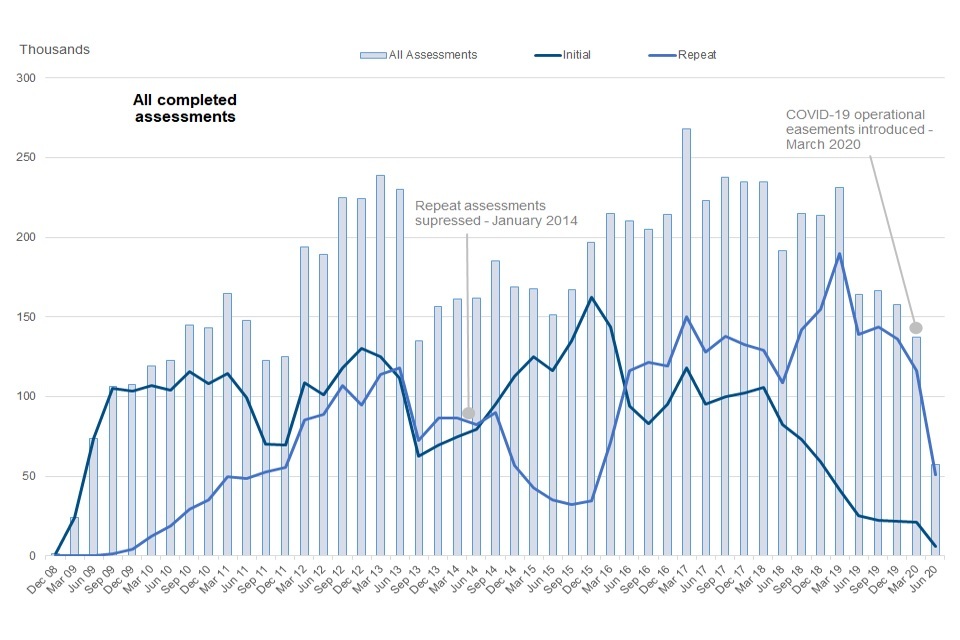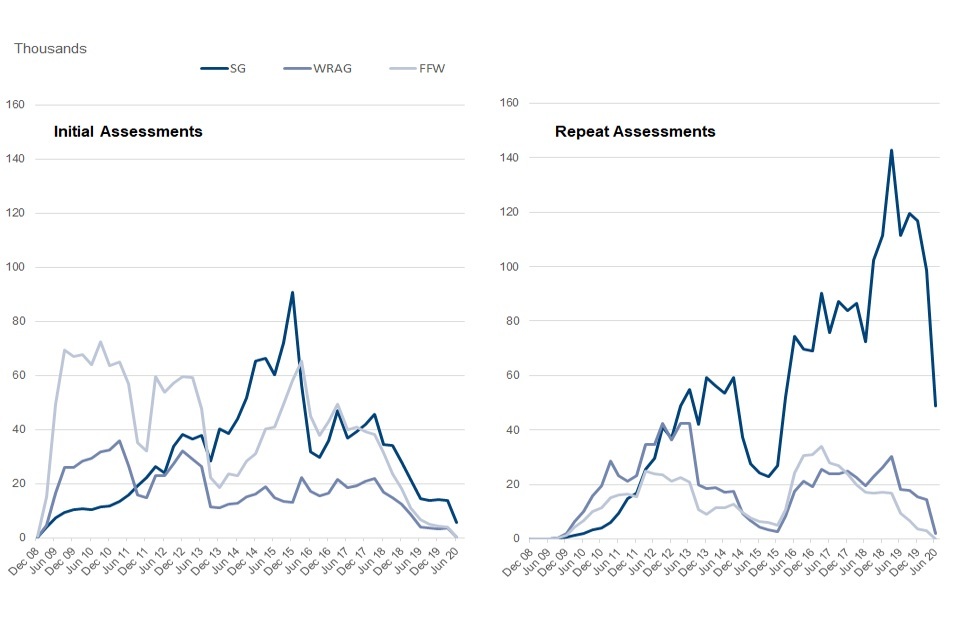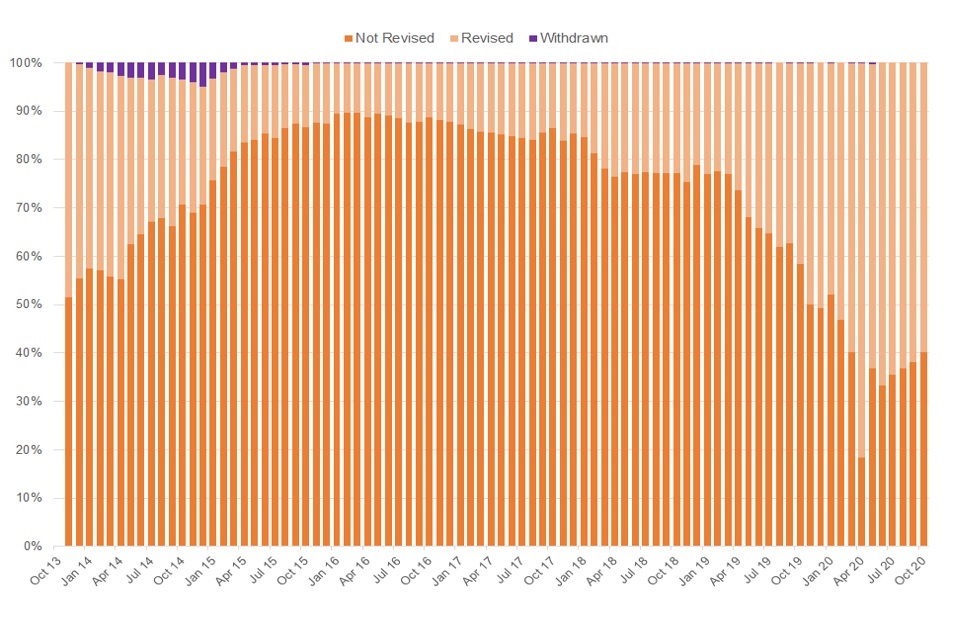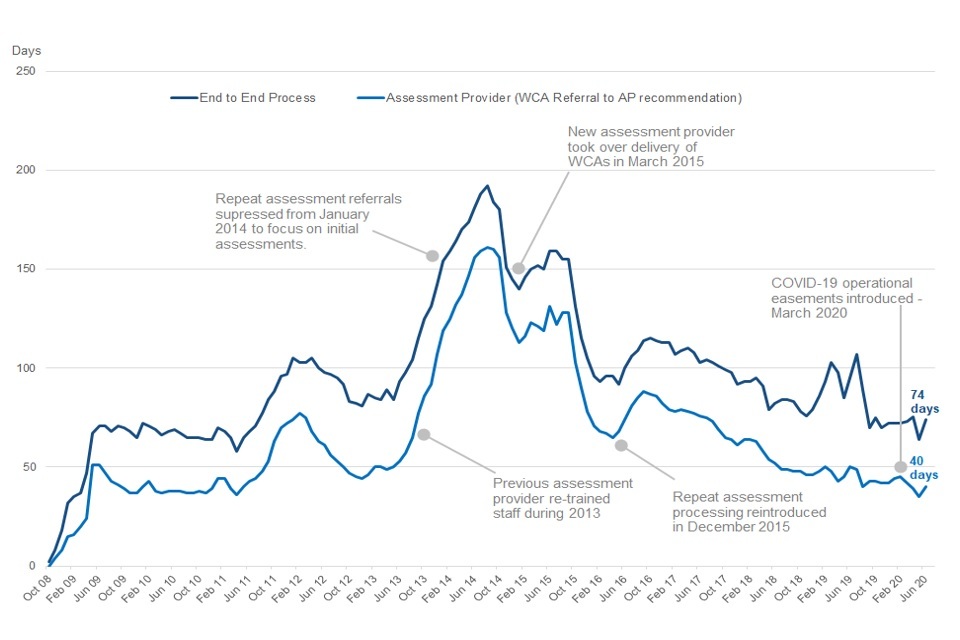ESA: Work Capability Assessments, Mandatory Reconsiderations and Appeals: January 2021
Published 14 January 2021
Applies to England, Scotland and Wales
The latest release of these statistics can be found in the collection of ESA: outcomes of Work Capability Assessments statistics.
This is a summary of the latest National Statistics on the outcomes of completed Employment and Support Allowance (ESA) Work Capability Assessments (WCA). The publication covers information on both initial and repeat ESA assessments in Great Britain. This release of the publication has been delayed from December 2020.
This release consists of a reduced set of tables due to HM Courts and Tribunal Service (HMCTS) discovering issues with their appeals data which is used to create this release. We are therefore only able to publish data tables which are not based on information from the appeals data. This release includes:
- WCA outcomes of initial and repeat WCAs to end of June 2020
- End to end initial ESA claim clearance times to end of June 2020
- Mandatory Reconsideration (MR) information to end of October 2020: (i) number of MR registrations, (ii) number of MR decisions, (iii) MR outcomes by type of decision, (iv) Median MR clearance time
The information will be published as data tables rather than via Stat-Xplore. Once the issues with the appeals data is resolved future publications will include a complete backseries covering any missing tables.
This release does not include:
- Outcomes of assessments adjusted for appeal
- Reasons for assignment into Support Group (SG), Work Related Activity Group (WRAG)
- Appeal outcomes for Fit for Work (FfW) decisions
- Numbers from the experimental data which follows customers through the ESA journey, so numbers who complete a WCA, then go through to raise an MR and then go on to appeal
- Incapacity Benefit (IB) reassessment numbers and outcomes
- Outcome of assessment by International Classification of Diseases (ICD) group: Functional impairment reasons for WRAG outcomes
Universal Credit (UC) was rolled out to every Jobcentre across Great Britain by December 2018 and has now replaced income-related ESA for most new claimants. This has greatly changed the volume and composition of new claims to ESA.
Note: Information is only available for claims that began at least 6 months following the assessment date, or 9 months following the date of claim. This is because of the time required for the customer journey to end and for the information recorded to be as complete as possible.
1. Main stories
Figures for this release reflect the disruptions caused by the coronavirus (COVID‑19) pandemic, which has led to changes to operational procedures. Such changes were necessary to process claims while keeping customers and staff safe, while ensuring those eligible received their benefits. Operational measures implemented in March 2020 in response to COVID-19 included the suspension of face-to-face health assessments. Where possible, telephone or paper-based assessments have been used.
The statistics show:
- the majority, 51,000 (89%), of the total 57,000 ESA-WCA assessments completed in the latest quarter to June 2020 were repeat assessments
- there were 6,100 completed initial WCAs in the latest quarter
-
both repeat and initial WCA assessments decreased sharply in the quarter to June 2020 compared with the previous quarter. Repeat WCAs fell by 56% and initials by 71%
-
the number of registered MRs has continued to fall in the latest year and in the latest month decreased from 190 in July 2020 to 160 in October 2020
-
the MR monthly median clearance time increased from 5 days in the previous month to 8 days in October 2020
- the median end-to-end clearance time for claimants completing their initial WCA increased by 1 day from March 2020 to stand at 74 days in June 2020
2. What you need to know
The sources of the statistics are:
- DWP’s benefit administration datasets including MR data
- healthcare provider assessment data
COVID-19 operational easements
In response to the COVID-19 pandemic, DWP made a number of changes to its processing of benefit claims to ensure people in need of financial help could access benefits.
DWP temporarily suspended face-to-face health assessments from 17 March 2020. This aimed at reducing the risk of exposure to coronavirus, hence safeguarding the health of individuals claiming health and disability-related benefits, many of whom are likely to be at greater risk due to their pre-existing health conditions. This means that people claiming ESA were not required to attend face-to-face assessments. However, paper-based assessments continued and telephone assessments were introduced from 7 May 2020.
The typical customer journey, prior to the COVID-19 easements, is as follows:
- Claimant registers for ESA – payment issued at assessment rate.
- Claimant referred for WCA and issued the “Capability to Work” questionnaire.
- Claimant completes and returns questionnaire.
- Assessment Provider (AP) may conduct face-to-face assessment or paper-based assessment and provides recommendation to DWP.
- DWP makes a decision based on the AP recommendation. Those found eligible for ESA are either placed in the WRAG, which offers support in preparing for work, or the SG if they are unable to work or complete work-related activity. Those not eligible are found FfW.
- If the claimant disagrees with this decision, then depending on the nature of the decision they will either (i) have to request an MR (before they can appeal); or (ii) be able to appeal straightaway.
Note: As a result of High Court decision in July 2020, MR has been discontinued for any claimant who, having been found Fit for Work (FfW) following a WCA would, if they appealed, be paid ESA pending the outcome of that appeal. This is known as Payment Pending Appeal (PPA). Not all claimants qualify, and it applies only to Fit for Work disallowance decisions, not decisions such as disallowance due to Failure to Return a Questionnaire or Failure to Attend a WCA.
Rounding policy
Since March 2017, the following rounding policy has been applied to the statistical release. Please note that percentages shown within the release are calculated using figures prior to rounding.
| From | To | Rounded to |
|---|---|---|
| 0 | 1,000 | 10 |
| 1,001 | 10,000 | 100 |
| 10,001 | 100,000 | 1,000 |
| 100,001 | 1,000,000 | 10,000 |
| 1,000,001 | 10,000,000 | 100,000 |
| 10,000,001 | 100,000,000 | 1,000,000 |
3. Assessment volumes and outcomes: ESA initial and repeat assessments
Initial and repeat assessment volumes for all outcomes have sharply decreased this quarter.
After the introduction of ESA WCA the number of completed assessments gradually increased, reaching a peak of 240,000 completed assessments in March 2013. At the end of 2013, ESA WCA completed assessment volumes dropped substantially, driven by both changes in volumes of initial and repeat assessments. This dip in volumes coincides with a period in which operational efforts were focused on clearing residual new claims in the system in order to manage the number of outstanding cases awaiting a decision and reduce delays for claimants. During this period, claimants could still request a repeat assessment due to a change of circumstances, such as the development of a new condition or deterioration of the existing one.
From late 2013 onwards, the number of ESA WCA completed assessments have risen substantially up to 220,000 in March 2016. This increase was driven by a variety of factors, including the spike in initial completed assessments following changes in operational procedures, and the re-introduction of repeat assessments in December 2015. Following this period of growth, the number of completed assessments levelled off and then followed a downward trend, with only 57,000 assessments being completed in the quarter to June 2020, a decrease of 58% when compared to the quarter to March 2020 which can be partly attributed to the suspension of face to face assessments in March 2020 in response to the COVID-19 pandemic. This has been the second lowest number of completed assessments since the introduction of ESA.
All completed assessments by quarter, December 2008 to June 2020

Source: Data tables: ESA Work Capability Assessments under ESA WCA by date of decision made.
In the quarter to June 2020, the majority (89%) of completed ESA WCA assessments in the latest quarter were repeat assessments. Only 11% of completed assessments were initial ESA claims.
Between December 2008 and March 2013 both initial and repeat assessments followed an upward pattern, with the number of completed initial assessments being consistently higher than repeats. Following this period of growth, there was a sharp decrease in both the number of initial and repeat assessments, followed by a spike in initial assessments as repeat assessments continued to decrease (160,000 initial and 35,000 repeat assessments in the quarter to December 2015). After peaking in the quarter to December 2015, there was a downward trend in the number of completed initial assessments. For the same period, completed repeat assessments increased throughout time, with numbers of repeats exceeding initials in the quarter to June 2016 (120,000 repeat assessments and 94,000 initial assessments). Since then, the number of completed repeat assessments has consistently surpassed the number of initial assessments, with the quarter to June 2019 seeing large differences. For the quarter to June 2019, repeat assessments accounted for 85 % of all completed assessments.
In the quarter to June 2020, both initial and repeat assessments have considerably decreased, with initial assessments reaching the second lowest figure (6,100) since the introduction of ESA. These decreases reflect the impact of operational changes in response to the COVID-19 pandemic, which led to changes in operational procedures to process claims. Repeat assessments accounted for 89% of completed ESA WCA assessments in the latest quarter.
Only 11% of completed assessments were initial assessments. This decrease in the proportion of initial assessments is partly a result of the introduction of Universal Credit (UC) replacing most income-related new claims to ESA, which greatly changed the volume and composition of new claims to ESA. The number of completed assessments is also affected by the suspension of face-to-face assessments in favour of paper based and telephony assessments: repeat assessments are more likely to be suitable for a paper-based assessment.
Initial and repeat assessment outcomes, December 2008 to June 2020

Source: Data tables: ESA Work Capability Assessments under ESA WCA by date of decision made.
Of the 6,100 initial assessments completed in the quarter to June 2020, 6,000 resulted in ESA entitlement.
Assessment outcomes for ESA initial assessments by date of decision made, December 2008 to June 2020

Source: Data tables: ESA Work Capability Assessments under ESA WCA by date of decision made.
ESA completed assessment outcomes for all completed assessments for the latest quarter show a sizeable increase in Support Group (SG) allocations. The majority of ESA initial and repeat assessments are assigned to SG (91% and 96% respectively).
Assessment outcomes for ESA initial assessments for the quarter ending in June 2020
| ESA Initial | Percentages |
|---|---|
| Support Group | 91% |
| Work Related Activity Group | 6% |
| Fit For Work | 2% |
Assessment outcomes for ESA repeat assessments for the quarter ending in June 2020
| ESA Repeat | Percentages |
|---|---|
| Support Group | 96% |
| Work Related Activity Group | 4% |
| Fit For Work | 0% |
The proportion of ESA repeat assessments assigned to SG has increased from 85% last quarter to 96% this quarter, while the proportion found FfW has decreased to 0%. This is a direct result of the suspension of face-to-face assessments in favour of paper-based and telephony assessments. The latest trend for WCA outcomes can be partly attributed to the fact that only SG decisions could be made via telephony and paper-based assessments from March 2020 to the period covered in these statistics.
4. ESA WCA Mandatory Reconsideration registrations, clearances and clearance times
MR registrations have decreased to reach 160 in the quarter to October 2020. Clearances closely follow the same trend.
By the end of October 2020, a total of 850,000 MRs have been registered. Of these, 99.6% had been cleared. The number of MR registrations and clearances within each month fluctuate over time:
- the number of MR registrations and clearances gradually increased between April 2013 and March 2017 as volumes of ESA customers increased
- MR registrations and clearances volumes peaked in March 2017 but have followed a downward trend since
- latest figures for MR registrations and clearances (160 and 170 in the quarter to October 2020) are the lowest since the introduction of MRs in October 2013
When the MR process was first introduced, the number of MR clearances was lower than the number of MRs registered. As the MRs became established, clearance volumes started increasing and became comparable to registration volumes in recent years.
The number of ESA WCA MR registrations and clearances should be seen in context with the decrease of ESA claims as UC is rolled out, the changing composition of assessment outcomes, the effect of the COVID-19 pandemic and that, in some circumstances, MR has now been discontinued and claimants can appeal straightaway.
Mandatory reconsiderations registrations and clearances, October 2013 to October 2020

Source: Data tables: ESA Work Capability Assessments under Mandatory Reconsiderations – Registrations and Mandatory Reconsiderations - Clearances.
The median MR clearance dropped at 3 days in July 2020, but has increased since then to stand at 8 days in October 2020.
The MR average clearance times is derived using calendar days by calculating the median of the time taken from the date the Benefit Centre (BC) has decided the MR to be valid, having considered any new information, until the date the decision is cleared by the decision maker at the Dispute Resolution Team (DRT). These dates are obtained from the DWP Decision Making and Appeals Case Recorder (DMACR) reporting system. The total clearance time therefore includes the time taken to transfer the case to DRT.
Immediately after the introduction of MRs, in October 2013, the median average time taken to clear MRs has sharply increased to stand at 37 calendar days in May 2014. MR clearance times have significantly decreased from their peak in May 2014, and have been quite volatile since, with peaks in September 2016 (15 days), August 2018 (16 days) and January 2020 (16 days).
For the month ending October 2020, it took on average 8 calendar days to clear MRs, a 5 calendar days’ increase from July 2020. Despite this increase, the MR median clearance time in October 2020 compares to the MR median clearance time in March 2020 (6 days), in the pre COVID-19 period.
Mandatory reconsiderations median clearance times, October 2013 to October 2020

Source: Data tables: ESA Work Capability Assessments under Mandatory Reconsiderations - Clearances.
5. ESA WCA Mandatory Reconsiderations outcomes
Since January 2020 there has been a decreasing trend in the number of MR decisions, with only 170 MR decisions being made in the month ending October 2020.
From October 2013 to October 2019, the majority of ESA WCA assessment outcomes were not revised at MR stage. Since then, the proportion of assessment outcomes where the award changed after the MR gradually increased, with some fluctuation. The proportion of MR decisions resulting in a change in award rose sharply from 54% in February 2020 to 82% in April 2020, reflecting the new operational approaches as well as COVID-19 impact. Between June 2020 and October 2020, the proportion of MR decisions leading to a change in award decreased to 60% in the latest month (October 2020), a similar level to March 2020.
Percentage of ESA WCA mandatory reconsiderations by outcome, October 2013 to October 2020

Source: Data tables: ESA Work Capability Assessments under Mandatory Reconsiderations – Clearances.
The increase in the proportion of revised decisions since 2019 should be seen in context alongside the large reduction in MRs as well as the changing composition of WCA decisions caused by a number of factors. These include the COVID-19 pandemic, the introduction of UC replacing most income-related new claims to ESA, and new operational approaches to gather additional oral and written evidence at the MR stage.
Mandatory Reconsiderations – Decisions by type for the quarter ending in October 2020
| Decisions Made | Percentages |
|---|---|
| Customer failed to attend WCA, provide medical evidence or return questionnaire | 6% |
| Customer disputes FFW decision | 25% |
| Customer disputes ESA group allocations | 67% |
| Others/Unknown | 2% |
Source: Data tables: ESA outcomes of Work Capability Assessments
Mandatory Reconsiderations – Decision Outcomes for the quarter ending in October 2020
| Decision Outcomes | Revised | Not Revised |
|---|---|---|
| Customer failed to attend WCA, provide medical evidence or return questionnaire | 75% | 25% |
| Customer disputes FFW decision | 53% | 47% |
| Customer disputes ESA group allocations | 62% | 38% |
Source: Data tables: ESA outcomes of Work Capability Assessments
The majority of ESA WCA MR raised in the quarter to October 2020 were made on disputes about ESA group allocations and FfW decisions.
In the quarter ending October 2020 approximately 67% of MR decisions were made on disputes on ESA group allocation, followed by disputes on FfW assessment outcomes (25%). Of all MR decisions made in the quarter to October 2020, 6% were on disputes where the claimant had not followed the claim procedures correctly. These reasons include failing to return the initial questionnaire, failing to provide medical evidence or not attending the assessment. Across all categories, a majority of disputes were revised.
Patterns in the reasons for why customers go on and register an MR, are different in recent months due to ongoing COVID-19 disruption, since reassessment activity has not restarted for all types of claim and overall numbers of ESA WCA reassessments are low.
6. ESA WCA customer journey clearance times for initial claims (experimental statistics)
The median end-to-end clearance times for initial ESA WCA claims is 74 calendar days for the latest month in June 2020.
After 2008, the median end-to-end clearance time generally followed an upward trend, reaching a peak of 192 calendar days in August 2014. Since then, it has reduced considerably to 93 days in February 2016 and 79 days in December 2018. The end-to-end clearance time saw sharp increases in early 2019 (103 days in March 2019 and 107 in July 2019), to fall again to 70 days in September 2019. In the month to June 2020, the end-to-end median clearance times (claim registration to final DWP award decision) for initial claims increased from 64 (in May 2020) to 74 calendar days. However, despite this increase, the median end-to-end clearance times in June 2020 compares to a median of 73 days in February 2020 similar to (pre COVID-19 period) waiting times.
The end-to-end journey time will be affected by a variety of factors, including the completion of roll-out of UCFS and seasonal impacts. The end-to-end process accounts for the time between the customer’s referral to the AP and the AP recommendation. This stage will usually involve a WCA assessment and includes the waiting time for the customer to complete and return the questionnaire. Multiple referrals are sometimes required before an assessment is completed and a recommendation received, as customers may not attend appointments or return questionnaires.
In June 2020, the average time between referral to the AP and their recommendation was 40 days. The AP clearance times followed the same trend as the median end-to-end clearance times, with an increase from 35 (in May 2020) to 40 calendar days. Despite the increase in the latest month (June 2020), the AP clearance time is still lower than the 45 days recorded in February 2020 (pre COVID-19 period).
Median clearance times for completed initial claims, October 2008 to June 2020

Source: Data tables: ESA Work Capability Assessments under Clearance Times for Initial Claims.
Monthly clearance times (in weekdays) for individual stages of the ESA WCA process
| Clearance Type | April 2020 | May 2020 | June 2020 |
|---|---|---|---|
| Claim Registration to WCA Referral | 3 | 3 | 9 |
| WCA Referral to Assessment Provider (AP) Recommendation | 39 | 35 | 40 |
| AP recommendation to DWP decision | 19 | 14 | 11 |
| End-to-End ESA claim | 76 | 64 | 74 |
Note: The ‘end-to-end clearance times’ refer to time taken from claim registration to date of DWP decision. Claim registration date is the date the claimant has first contact with the department when making a claim to ESA. The DWP decision will include MRs where there is a completed decision.
7. About these statistics
The UK Statistics Authority has designated these statistics as National Statistics, in accordance with the Statistics and Registration Service Act 2007 and signifying compliance with the Code of Practice for Statistics. This badge does not currently apply to the experimental cohort figures or ESA clearance times.
Key uses of the statistics include:
-
providing the evidence base for assessing the potential effect of changes, monitoring and evaluation of DWP policy
-
answering Parliamentary Questions and Freedom of Information requests and Forecasting benefit expenditure (in conjunction with expenditure statistics)
-
policy development and evaluation by local authorities and other welfare to work and pensions stakeholders and providers
This release only includes ESA WCAs.
This release does not capture:
- UC WCAs
- UC MRs
- UC appeals
Recent trends in these ESA WCA statistics will be affected by the roll out of UC.
Terminology
| Term | Definition |
|---|---|
| Registration | Claimant registers an application for a WCA, MR or appeal. |
| Clearance | DWP decision maker has determined whether the claimant should or should not be entitled to claim ESA. |
| Mandatory Reconsideration | Claimant wishes to dispute a decision made on their claim and requests DWP to reconsider the decision. |
| MR clearance time | The clearance time begins from the point the MR is raised on the DWP administrative system by the Benefit Centre as a valid MR, having considered whether they can initially change the decision in the light of any new information. The total clearance time therefore includes the time taken to transfer the case to the Dispute Resolution Team and the time taken for the decision maker to make a decision. |
| Repeat assessment | An existing claim that has been reassessed for ESA, as opposed to a new claim. A repeat assessment is the second or subsequent WCA undertaken on an existing, continuous ESA claim, usually between 3 and 24 months after the previous assessment. These claimants will have already been assessed as having a limited capability for work at their initial WCA and the repeat assessment will assess if their capability for work has changed. |
Development of UC WCA official statistics
DWP are currently developing official statistics on numbers of UC claimants who go through a WCA and related outcomes. When the information will be robust and accurate enough for publication as official statistics, we will preannounce its release in the GOV.UK release calendar.
Where to find out more
The statistics in this release are published as data tables rather than via Stat-Xplore. This is only a temporary measure and future publications will include a complete backseries covering any missing tables.
Read the methodology note for more detailed information on these statistics.
Read more about ESA.
Lead statistician: Ioana Criclevit
ISBN: 978-1-78659-285-9
